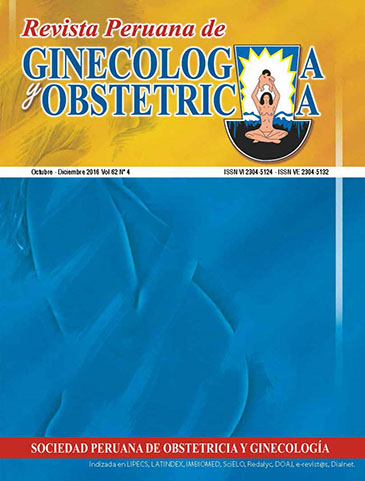El lastre de la morbilidad materna severa en la Obstetricia contemporánea
DOI:
https://doi.org/10.31403/rpgo.v62i1940Resumen
La salud materna se está deteriorando en el mundo debido a múltiples factores, entre los cuales se encuentran el incremento de las tasas de obesidad, las enfermedades crónicas como la hipertensión crónica, la diabetes mellitus tipo II y la enfermedad cardiovascular, así como la edad materna avanzada al momento de la concepción. Estos factores sumados a la mayor tasa de cesáreas, la falta de estandarización de la práctica clínica y la atención inapropiada de las urgencias obstétricas son las que contribuyen tremendamente al incremento de complicaciones obstétricas graves y muerte materna. En años recientes, las organizaciones de salud nacionales e internacionales han propuesto nuevas definiciones de la morbilidad materna severa. La Organización Mundial de la Salud (OMS) define ‘morbilidad materna extrema’ (MME) como una serie de ocurrencias que parten de la buena salud y se complican al punto de poner en riesgo de muerte por disfunción o falla orgánica. Al contrario, los Centros para el Control y Prevención de las Enfermedades (CDC) en los Estados Unidos clasifican como ‘morbilidad materna grave’ (MMS) si un embarazo se complica con una o más de las veinticinco complicaciones/procedimientos clínicos de la Clasificación Internacional de Enfermedades (ICD-9) asociados con un riesgo alto de mortalidad materna. Aunque cada organización emplea una aproximación diferente, la información existente indica que los criterios diagnósticos utilizados por el CDC o la OMS predicen con mucha precisión aquellas gestaciones complicadas con una ‘verdadera’ complicación materna que amenaza su vida. Estas definiciones son esenciales para comprender mejor la dimensión de la enfermedad. Cada hospital que provee atención de la salud materna deberá adoptar la definición que mejor se adapte a su propio sistema de salud y es urgido a incorporar iniciativas que puedan reducir las complicaciones maternas severas. Un paso fundamental para resolver este aspecto es establecer una revisión estandarizada o proceso de auditoría conducido por un equipo multidisciplinario que analice sistemáticamente los casos de morbilidad y mortalidad materna grave. Este equipo está encargado de evaluar las deficiencias de los proveedores de salud, de la institución y de los niveles del sistema. Además, tiene la obligación de implementar programas que mejoren la calidad de la atención. Los sistemas de alarma materna, compuestos por un grupo de parámetros fisiológicos anormales, han sido creados con el objetivo de alertar al proveedor sobre el deterioro de las condiciones de la paciente, exigiendo una pronta evaluación, reduciendo así la morbimortalidad materna. Recientemente se ha demostrado que al unir estos sistemas de alarma a las guías clínicas estandarizadas y basadas en la evidencia que están dirigidas a las complicaciones clínicas obstétricas más comunes permite mayores beneficios para el manejo de la paciente y mejora los resultados clínicos. A pesar de los avances en la detección y manejo temprano de la morbilidad materna severa, existe una necesidad de mayor investigación para estandarizar las definiciones a nivel regional, nacional e internacional y validar la efectividad de los sistemas de alarma temprana en diferentes escenarios clínicos. Además, es necesario implementar nuevas estrategias para mejorar los resultados maternos a largo plazo e incorporar otras medidas preventivas iniciadas aún antes de la concepción, de manera que se logre disminuir aún más las tasas de complicaciones graves y la muerte materna.Descargas
Descargas
Publicado
2017-01-07
Cómo citar
Mateus, J. (2017). El lastre de la morbilidad materna severa en la Obstetricia contemporánea. Revista Peruana De Ginecología Y Obstetricia, 62(4), 397–404. https://doi.org/10.31403/rpgo.v62i1940
Número
Sección
Simposio
















